
The German auxiliary cruiser Kormoran (HSK-8) was a Kriegsmarine merchant raider of World War II. Originally the merchant vessel Steiermark ("Styria"), the ship was acquired by the navy following the outbreak of war for conversion into a raider. Administered under the designation Schiff 41, 'Ship 41', to the Allied navies she was known as "Raider G". The largest merchant raider operated by Germany during World War II, Kormoran ("cormorant") was responsible for the destruction of 10 merchant vessels and the capture of an 11th during her year-long career in the Atlantic and Indian oceans.
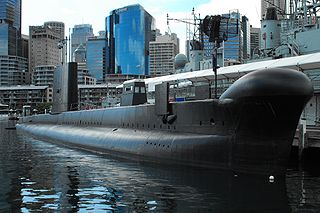
HMAS Onslow is one of six Oberon-class submarines, previously operated by the Royal Australian Navy (RAN). The submarine was named after the town of Onslow, Western Australia, and Sir Alexander Onslow, with the boat's motto and badge derived from Onslow's family heritage. Ordered in 1963, Onslow was laid down at the end of 1967 by Scotts Shipbuilding and Engineering Company in Scotland, launched almost a year later, and commissioned into the RAN at the end of 1969.

HMAS Melbourne (R21) was a Majestic-class light aircraft carrier operated by the Royal Australian Navy (RAN) from 1955 until 1982, and was the third and final conventional aircraft carrier to serve in the RAN. Melbourne was the only Commonwealth naval vessel to sink two friendly warships in peacetime collisions.

HMAS Sydney, named for the Australian city of Sydney, was one of three modified Leander-class light cruisers operated by the Royal Australian Navy (RAN). Ordered for the Royal Navy as HMS Phaeton, the cruiser was purchased by the Australian government and renamed prior to her 1934 launch.

HMAS Canberra (I33/D33), named after the Australian capital city of Canberra, was a Royal Australian Navy (RAN) heavy cruiser of the Kent sub-class of County-class cruisers. Constructed in Scotland during the mid-1920s, the ship was commissioned in 1928, and spent the first part of her career primarily operating in Australian waters, with some deployments to the China Station.

On 19 November 1941, the Australian light cruiser HMAS Sydney and the German auxiliary cruiser Kormoran engaged each other in a battle off the coast of Western Australia. Sydney, with Captain Joseph Burnett commanding, and Kormoran, under Fregattenkapitän Theodor Detmers, encountered each other approximately 106 nautical miles off Dirk Hartog Island. The single-ship action lasted half an hour, and both ships were destroyed.

From 31 May to 8 June 1942, during World War II, Imperial Japanese Navy submarines made a series of attacks on the Australian cities of Sydney and Newcastle. On the night of 31 May – 1 June, three Ko-hyoteki-class midget submarines, each with a two-member crew, entered Sydney Harbour, avoided the partially constructed Sydney Harbour anti-submarine boom net, and attempted to sink Allied warships. Two of the midget submarines were detected and attacked before they could engage any Allied vessels. The crew of M-14 scuttled their submarine, whilst M-21 was successfully attacked and sunk. The crew of M-21 killed themselves. These submarines were later recovered by the Allies. The third submarine attempted to torpedo the heavy cruiser USS Chicago, but instead sank the converted ferry HMAS Kuttabul, killing 21 sailors. This midget submarine's fate was unknown until 2006, when amateur scuba divers discovered the wreck off Sydney's northern beaches.

HMAS Armidale (J240), named for the then town of Armidale, New South Wales, was one of 60 Bathurst-class corvettes constructed during World War II, and one of 36 initially manned and commissioned solely by the Royal Australian Navy (RAN).

HMAS Patricia Cam was an auxiliary vessel operated by the Royal Australian Navy during World War II. She was sunk by a Japanese aircraft in 1943.

No. 101 Flight RAAF was a Royal Australian Air Force fleet co-operation flight equipped with amphibian aircraft. The flight was formed on 1 July 1925, and operated from the Royal Australian Navy seaplane tender HMAS Albatross between 1929 and 1933. After Albatross paid off the flight's aircraft operated from the RAN's heavy cruisers HMAS Australia and HMAS Canberra. No. 101 Flight was expanded to form No. 5 Squadron on 20 April 1936.
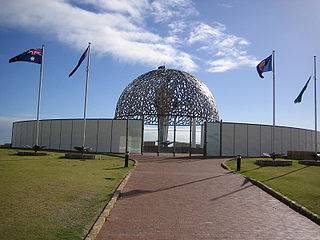
Numerous attempts were made to find the Australian cruiser HMAS Sydney and the German auxiliary cruiser Kormoran, which were both lost in a sea battle in 1941. Efforts immediately after the battle focused on finding Sydney when she failed to return to port. While searchers located over 300 survivors from Kormoran, none of the 645 aboard the Australian warship were found. In March 2008, shipwreck hunter David Mearns commenced a search for the two wrecks. Kormoran was located on 12 March in close proximity to the sinking position given in German accounts. Using the survivor's information on Sydney's last known heading, Mearns and his search team located Sydney on 17 March.
The Melbourne–Voyager collision, also known as the Melbourne–Voyager incident or simply the Voyager incident, was a collision between two warships of the Royal Australian Navy (RAN); the aircraft carrier HMAS Melbourne and the destroyer HMAS Voyager.

The Melbourne–Evans collision was a collision between the light aircraft carrier HMAS Melbourne of the Royal Australian Navy (RAN) and the destroyer USS Frank E. Evans of the United States Navy (USN). On 3 June 1969, the two ships were participating in SEATO exercise Sea Spirit in the South China Sea. Around 3:00 am, when ordered to a new escort station, Evans sailed under Melbourne's bow, where she was cut in two. Seventy-four of Evans's crew were killed.
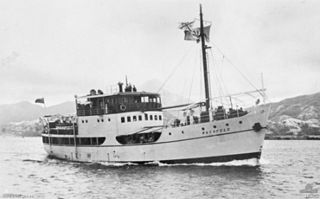
HMAS Matafele was a small cargo and passenger vessel which was operated by Burns Philp from 1938 to 1942 and the Royal Australian Navy (RAN) from 1943 until she was lost with all of her crew as a result of an accident in June 1944.
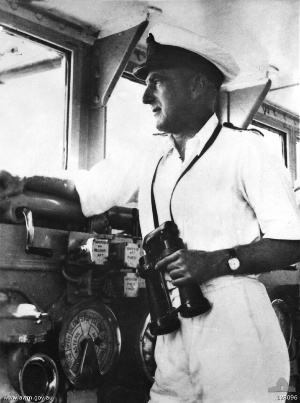
Joseph Burnett was a Royal Australian Navy (RAN) officer most widely known as the captain of the light cruiser HMAS Sydney in the battle between HMAS Sydney and HSK Kormoran on 19 November 1941. He fought in both the First World War and Second World War, serving in the RAN and the Royal Navy (RN), and went down with the Sydney off the coast of Western Australia.

The Carley float was a form of invertible liferaft designed by American inventor Horace Carley (1838–1918). Supplied mainly to warships, it saw widespread use in a number of navies during peacetime and both World Wars until superseded by more modern rigid or inflatable designs. Carley was awarded a patent in 1903 after establishing the Carley Life Float Company of Philadelphia.
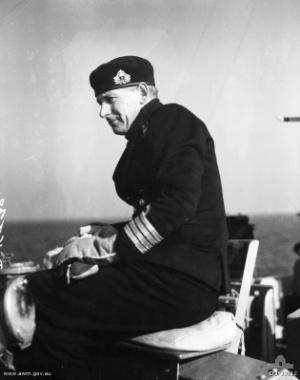
Rear Admiral Otto Humphrey Becher, & Bar was a senior officer in the Royal Australian Navy (RAN). Born in Harvey, Western Australia, Becher entered the Royal Australian Naval College in 1922. After graduating in 1926, he was posted to a series of staff and training positions prior to specialising in gunnery.
SIEV 36 was a vessel from Indonesia that exploded and sank off Ashmore Reef, Australia on 16 April 2009. The vessel, carrying 47 refugees and two crew, was intercepted by the Royal Australian Navy patrol boat HMAS Albany early on 15 April. A boarding party secured the vessel, but failed to locate two canisters of petrol. Although it was intended to take the crew and passengers to Christmas Island for processing, a notice informing the crew that their vessel may be returned to Indonesia was presented, and the passengers were kept in the dark about their destination. While waiting for transportation to arrive, Albany and SIEV 36 sailed in a holding pattern, with the Indonesian boat taken in tow overnight. A second patrol boat, HMAS Childers, arrived that evening, and was directed to provide a boarding party and take care of the vessel starting at 06:00 on 16 April.
The Slamat disaster is a succession of three related shipwrecks during the Battle of Greece on 27 April 1941. The Dutch troopship Slamat and the Royal Navy destroyers HMS Diamond and HMS Wryneck sank as a result of air attacks by Luftwaffe Junkers Ju 87 dive bombers. The three ships sank off the east coast of the Peloponnese during Operation Demon, which was the evacuation of British, Australian and New Zealand troops from Greece after their defeat by invading German and Italian forces.
Wes Olson is an independent researcher and author based in Perth Western Australia. His work has concentrated on Australian military history during both World Wars.















